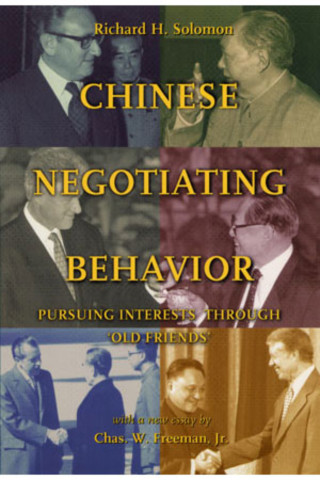Catalog
- Sort by
Taking an in-depth look at cases of the two Germanys, the United States and China, and Israel and Egypt, Armstrong examines why initiatives by Brandt, Nixon/Carter and Mao, and Sadat and Begin succeeded where previous attempts at rapprochement had failed.
Japanese representatives bring to the negotiating table a distinctive mind-set and behavioral style, one that’s largely free of gamesmanship and histrionics but that’s nonetheless frequently exasperating.
This volume explores four recent U.S.–Japanese negotiations—two over trade, two over security-related issues—looking for patterns in Japan’s approach and behavior. In the first three cases, veteran Japanologist Michael Blaker finds the same fundamental style—coping. “Coping captures the go-with-the-flow essence of the Japanese bargaining approach”: cautious, methodical, low key, resistant, apprehensive, and above all defensive. In the fourth case, Ezra Vogel and Paul Giarra recount how the United States and Japan fashioned a new security framework for their relationship in the 1990s. Vogel and Giarra show that close personal relationships, mutual trust, and a common purpose can foster flexible, fast, and fruitful negotiations.
Each case study explains the cultural as well as political, institutional, and personal factors and assesses their influence. A concluding chapter draws out common threads from the four studies, suggests how U.S. negotiators can maximize negotiating efficacy, and points the way toward a new and clearer understanding of Japanese bargaining behavior.
After two decades of hostile confrontation, China and the United States initiated negotiations in the early 1970s to normalize relations. Senior officials of the Nixon, Ford, Carter, and Reagan administrations had little experience dealing with the Chinese, but they soon learned that their counterparts from the People’s Republic were skilled negotiators.
This study of Chinese negotiating behavior explores the ways senior officials of the PRC—Mao Zedong, Zhou Enlai, Deng Xiaoping, and others—managed these high-level political negotiations with their new American “old friends.” It follows the negotiating process step by step, and concludes with guidelines for dealing with Chinese officials.
Originally written for the RAND Corporation, this study was classified because it drew on the official negotiating record. It was subsequently declassified, and RAND published the study in 1995. For this edition, Solomon has added a new introduction, and Chas Freeman has written an interpretive essay describing the ways in which Chinese negotiating behavior has, and has not, changed since the original study. The bibiliography has been updated as well.
In this eye-opening volume, the author examines the roots of the current southern Thai conflict, gives a detailed overview of the present crisis, documents the flight of the south's Buddhist community, and argues that the Thai government has woefully misplayed its hand.
Examines a host of critical environmental and resource issues through a “regional environmental security complex” that explores the potential for greater intersubjective understandings of regional environmental and natural resource problems and greater institutional collaboration and management.
For most Americans, the “exit” from Indochina occurred in 1973, with the withdrawal of the U.S. military from South Vietnam. In fact, the final exit did not occur until two decades later, after the collapse of the Republic of Vietnam in 1975, the Cambodian revolution, and a decade of Vietnamese occupation of Cambodia. Only in the early 1990s were the major powers able to negotiate a settlement of the Cambodia conflict and withdraw from the region.
This book recounts the diplomacy that brought an end to great power involvement in Indochina, including the negotiations for a UN peace process in Cambodia and construction of a “road map” for normalizing U.S.-Vietnam relations. In so doing, this volume also highlights the changing character of diplomacy at the beginning of the 1990s, when, at least temporarily, an era of military confrontation among the major world powers gave way to political management of international conflicts.
The authors offer a comprehensive examination of Pakistan’s internal security environment and the effectiveness of its criminal justice structures and assess the impact and utility of the principal United States initiatives to help Pakistan strengthen its internal security.
A terrible famine struck the most reclusive society on earth in 1994. Over the next five years, while the North Korean regime tried to hide the dreadful reality and the international community tried hard not to look, perhaps as many as 3 million people starved to death. In this powerful, provocative book, Andrew Natsios asks three overarching questions: What do we know about the origins and extent of the famine? Why did donor governments and organizations not do more to help? What are the consequences of the famine for North Korea and the lessons for the international community?
In the search for answers, Natsios supplements the scanty store of published sources by drawing on the testimony of thousands of refugees, on thousands of e-mails he received while heading an NGO effort to aid the victims, and on his own encounters with officials from North Korea as well as from Western governments. The picture he presents is a disturbing one: human misery on a biblical scale, a paranoid regime that sacrificed its own citizens to ideological rigidity and pride, and foreign governments that subordinated humanitarian impulses to political and diplomatic interests.
A compelling and revealing book for specialists and general readers alike,The Great North Korean Famine takes us not only behind the well-guarded borders of the brutally incompetent “Hermit Kingdom” but also into the policymaking labyrinth where ethics and politics clash in the struggle to shape foreign policy.
This revealing and challenging study of the impact of famine on North Korea not only significantly enlarges our understanding of that hermetic country but also urges us to reassess how we deal with it.
This book provides a historical and current review of the trends of six key India-Pakistan negotiations, largely over shared resources and political boundaries.










